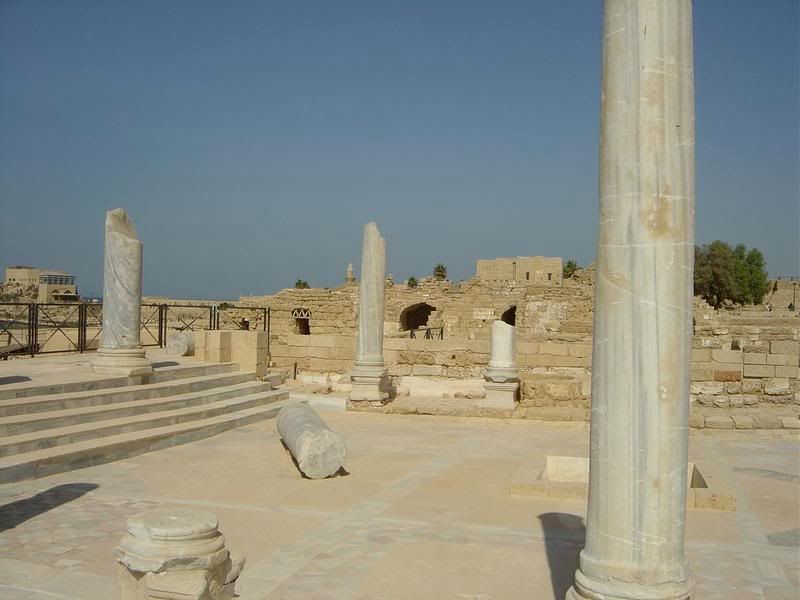 Israeli archaeologists excavating what they believe is the tomb of biblical King Herod said Wednesday they have unearthed lavish Roman-style wall paintings of a kind previously unseen in the Middle East and signs of a regal two-story mausoleum, bolstering their conviction that the Jewish monarch was buried here.Ehud Netzer, head of the team from Jerusalem's
Israeli archaeologists excavating what they believe is the tomb of biblical King Herod said Wednesday they have unearthed lavish Roman-style wall paintings of a kind previously unseen in the Middle East and signs of a regal two-story mausoleum, bolstering their conviction that the Jewish monarch was buried here.Ehud Netzer, head of the team from Jerusalem's  Hebrew University, which uncovered the site at the king's winter palace in the Judean desert in 2007, said his latest finds show work and funding fit for a king."What we found here, spread all around, are architectural fragments that enable us to restore a monument of 25 meters high, 75 feet high, very elegant, which fits Herod's taste and status," he told The
Hebrew University, which uncovered the site at the king's winter palace in the Judean desert in 2007, said his latest finds show work and funding fit for a king."What we found here, spread all around, are architectural fragments that enable us to restore a monument of 25 meters high, 75 feet high, very elegant, which fits Herod's taste and status," he told The  Associated Press in an interview Wednesday at the hillside dig in an Israeli-controlled part of the West Bank, south of Jerusalem.Herod is known for extensive building throughout the Holy Land.Netzer said that since finding fragments of one ornately carved sarcophagus in 2007, he and his team have found two more, suggesting that the monumental tomb may have been a royal family vault."A mausoleum like the one which we have here was generally built by a king but not (necessarily) only for himself, many times for his children and his family, like the famous mausoleum of Augustus in Rome, of Hadrian in Rome," he said. "It's not a surprise that we found here more than one sarcophagus."Herod was the Jewish proxy ruler of the Holy Land under imperial Roman occupation from 37 B.C. and reigned for more than six decades.
Associated Press in an interview Wednesday at the hillside dig in an Israeli-controlled part of the West Bank, south of Jerusalem.Herod is known for extensive building throughout the Holy Land.Netzer said that since finding fragments of one ornately carved sarcophagus in 2007, he and his team have found two more, suggesting that the monumental tomb may have been a royal family vault."A mausoleum like the one which we have here was generally built by a king but not (necessarily) only for himself, many times for his children and his family, like the famous mausoleum of Augustus in Rome, of Hadrian in Rome," he said. "It's not a surprise that we found here more than one sarcophagus."Herod was the Jewish proxy ruler of the Holy Land under imperial Roman occupation from 37 B.C. and reigned for more than six decades. The ruler is known to have had a taste for extravagance.
The ruler is known to have had a taste for extravagance.Netzer
 described the winter palace, built on a largely man-made hill 680 meters (2,230 feet) high, as a kind of "country club", with a pool, baths, gardens fed by pools and aqueducts and a 650-seat theater.
described the winter palace, built on a largely man-made hill 680 meters (2,230 feet) high, as a kind of "country club", with a pool, baths, gardens fed by pools and aqueducts and a 650-seat theater. In Herod's private box at the auditorium, the diggers discovered delicate frescoes depicting windows opening on to painted landscapes, one of which showed what appeared to be a southern Italian farm, said Roi Porat, one of Netzer's assistants on the digsJust visible in the paintings, dating from between 15-10 B.C., are a dog, bushes and what looks like a country villa.
In Herod's private box at the auditorium, the diggers discovered delicate frescoes depicting windows opening on to painted landscapes, one of which showed what appeared to be a southern Italian farm, said Roi Porat, one of Netzer's assistants on the digsJust visible in the paintings, dating from between 15-10 B.C., are a dog, bushes and what looks like a country villa.
No comments:
Post a Comment